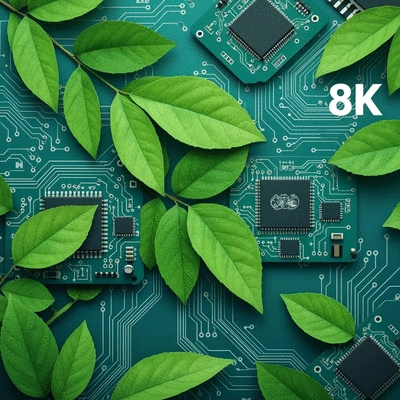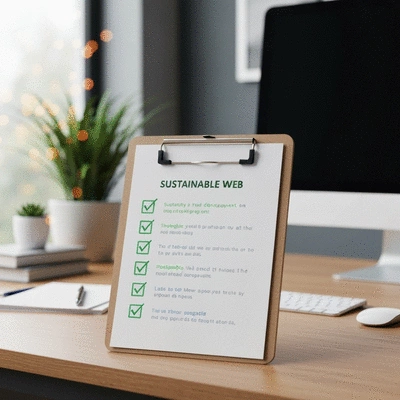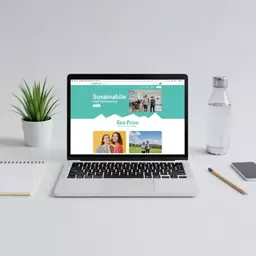In today’s digital world, the choices we make in web development can significantly impact our environment. Sustainability isn't just a trend—it's a necessity. By adopting eco-friendly web practices, we not only enhance our websites but also contribute to a greener future. Ready to embark on this journey?
What You Will Learn
- Understanding eco-friendly web development and its importance in reducing carbon footprints.
- Effective strategies for optimizing website performance while minimizing energy consumption.
- Assessing your website's carbon footprint to identify areas for improvement.
- Utilizing renewable energy hosting solutions to power your web projects sustainably.
- Creating practical checklists for implementing energy-efficient web practices.
- Exploring incentives and regulatory programs in Australia that support sustainable web development.
- Connecting with local sustainability initiatives to foster community engagement and innovation.
Key Pillars of Eco-Friendly Web Development
Eco-friendly web development is about minimizing environmental impact. Here are the core areas of focus. For insights into building a strong online presence, consider reading about website design in Sydney.
Energy-Efficient Coding
Streamlining code to reduce processing power and server load, minimizing energy consumption.
Sustainable Hosting
Choosing providers powered by renewable energy sources to reduce carbon footprint.
Optimized Design Choices
Implementing lazy loading, image compression, and efficient UI to conserve bandwidth and energy.
Regular Sustainability Audits
Assessing website performance and energy consumption to identify and implement improvements continuously.
Understanding Eco-Friendly Web Development in Australia
As a passionate advocate for sustainable web practices, I believe it’s essential to understand the world of eco-friendly web development. But what exactly does that mean? Simply put, eco-friendly web development focuses on creating websites that minimize their environmental impact. This practice involves using energy-efficient coding, sustainable hosting solutions, and design choices that reduce energy consumption. By embracing these principles, we can contribute to a greener planet while enhancing user experience!

When we talk about eco-friendly practices, it's vital to remember that every aspect of web development—from the design phase to deployment—can play a significant role in sustainability. So, let’s dive deeper into how we can implement these practices effectively!
What is Eco-Friendly Web Development?
Eco-friendly web development is about reducing the carbon footprint of websites throughout their lifecycle. This involves techniques that not only enhance functionality but also promote sustainability. By prioritizing energy efficiency in design and development, we can create a balance where aesthetics meet eco-consciousness.
- Utilizing resources efficiently to lower energy consumption
- Implementing coding practices that enhance performance
- Choosing hosting solutions powered by renewable energy
As we explore these aspects, it’s clear that sustainable web development isn’t just a trend but a necessary shift towards a more responsible digital landscape. Let’s make a commitment to create a better online experience while caring for our environment! For further reading on related topics, explore our guide on what WordPress is and how it's used.
Why Sustainability Matters in the Digital Space
In our increasingly digital world, the impact of technology on the environment is significant. Websites consume energy, and their carbon footprint can be substantial. By focusing on sustainability, we can mitigate this impact and promote a healthier planet. When you think about it, every little choice we make—like optimizing a website’s performance—can lead to a much larger collective benefit!
- Reduced energy consumption leading to lower operational costs
- Enhanced website performance and user experience
- Positive brand image through eco-conscious decisions
At Web Designer Near Me Digest, we are dedicated to supporting sustainable practices in web development. By adopting these principles, we can work together to make a meaningful difference in our digital landscape.
Assessing the Carbon Footprint of Your Website
To embark on the journey towards eco-friendly web development, it's crucial to assess the carbon footprint of your website. This means understanding how much energy your site consumes and identifying areas for improvement. Tools like sustainability audits can provide valuable insights into your website’s performance metrics!
- Evaluate hosting services and their energy sources
- Analyze code efficiency and website loading times
- Identify elements that can be optimized or reduced
By taking these steps, you can not only improve your website’s sustainability but also enhance its overall performance. Let’s embrace this journey towards greener web practices together!
Quick Summary
Here's a brief recap of the key points discussed so far:
- Eco-friendly web development focuses on minimizing environmental impact through energy-efficient coding and sustainable hosting solutions.
- Every aspect of web development, from design to deployment, contributes to sustainability.
- Assessing your website's carbon footprint is essential for identifying areas for improvement.
- Practical checklists can help Australian developers and designers implement sustainable practices effectively.
- Engaging with the eco-friendly web development community fosters collaboration and innovation.
Next Steps Towards Sustainable Web Practices
As we move towards a greener future, it's essential for Australian web developers and designers to embrace sustainable practices. Making eco-friendly choices not only enhances functionality but also demonstrates a commitment to environmental responsibility. Are you ready to take actionable steps? Let's explore practical checklists that can guide you!
Practical Checklists for Australian Developers and Designers
Creating a checklist can streamline your approach to sustainable web design. Here’s a concise guide to help you get started:
- Evaluate Hosting Options: Choose a green hosting provider that uses renewable energy sources.
- Optimize Images: Use compression techniques to reduce file sizes without sacrificing quality.
- Minimize Code: Streamline your code to decrease loading times and energy consumption.
- Implement Lazy Loading: Load resources only when necessary to save bandwidth and energy.
- Conduct Regular Audits: Use tools to assess your site's performance and identify areas for improvement.
By following this checklist, you’ll not only improve the sustainability of your projects but also enhance user experience. It’s a win-win!
Incentives and Regulatory Programs Supporting Eco-Friendly Development in Australia
Australia offers various incentives that promote sustainable web practices. Being aware of these can help you maximize your impact:
- Government Grants: Look for grants aimed at green technology and sustainable development.
- Tax Breaks: Some local governments provide tax incentives for businesses implementing eco-friendly technologies.
- Workshops and Training: Participate in training programs focused on sustainable practices in web design.
Staying informed about these programs not only supports your business but also contributes to the broader movement towards sustainability in web development.

Implementing Energy-Efficient Coding Practices in Your Projects
Energy-efficient coding is a critical component of sustainable web practices. Here are some techniques to consider:
- Reduce HTTP Requests: Streamline your site by minimizing the number of requests made to servers.
- Utilize CSS Sprites: Combine multiple images into a single file to cut down on loading times.
- Leverage Browser Caching: Enable caching to allow users’ browsers to store resources, speeding up load times on repeat visits.
By implementing these practices, you’ll ensure your projects not only function smoothly but also consume less energy—an important step toward sustainability! Discover more about effective strategies for building and maintaining your website by checking out our post on how to build a website from scratch.
Engaging with the Eco-Friendly Web Development Community
Connecting with like-minded individuals can amplify your efforts in sustainable web design. Building a community around eco-friendly practices fosters collaboration and innovation. Let's dive into how you can engage with this vibrant community!
Connecting with Local Sustainability Initiatives and Networks
There are numerous initiatives across Australia dedicated to promoting sustainability in web design. Here’s how you can connect:
- Attend Local Meetups: Join events focused on eco-friendly practices in web development.
- Participate in Online Forums: Engage with local networks via social media platforms or community forums.
- Collaborate with Other Designers: Partner with others in the industry to share knowledge and resources.
Networking with these groups can inspire new ideas and foster a sense of camaraderie, which is essential for driving change in our industry!
Encouraging Feedback and Sharing Experiences on Sustainable Practices
Don't underestimate the power of feedback! Sharing experiences can lead to valuable insights. Here’s how you can encourage open communication:
- Start Conversations: Pose questions on social media or community boards about sustainable practices.
- Share Your Journey: Document your own sustainability efforts on your blog or social media.
- Organize Workshops: Host sessions where professionals can learn from one another and exchange ideas.
Engaging in dialogue helps us learn from each other and strengthens our commitment to eco-friendly practices.
Exploring Digital Marketing Sustainability in Eco-Friendly Development
Digital marketing plays a significant role in the sustainability efforts of web development. It’s important to consider how your marketing strategies align with eco-friendly principles. Here are some areas to explore:
- Content Strategy: Focus on creating content that educates others about sustainability in web design.
- Green Certifications: Promote your commitment to sustainability through recognized certifications.
- Social Responsibility Campaigns: Run campaigns that highlight your eco-friendly initiatives and inspire others.
By aligning your marketing efforts with sustainable practices, you reinforce your brand’s commitment to the environment while engaging your audience in meaningful conversations. For further reading, consider our insights on the ultimate guide to local SEO for small businesses.
Conclusion: The Impact of Sustainable Choices in Web Development
As we reflect on our journey towards sustainability, it's clear that the choices we make today will have lasting impacts. Embracing eco-friendly practices in web development not only benefits our planet but also enhances our professional reputation.
Summarizing the Benefits of Eco-Friendly Web Development
In summary, sustainable web development results in:
- Reduced carbon footprint
- Enhanced user experience
- Increased brand loyalty
- Compliance with regulations
These benefits underscore the importance of integrating sustainability into every aspect of web design.
Call to Action: Start Your Journey Towards Sustainability Today
Are you ready to make a difference? At Web Designer Near Me Digest, we encourage you to take that first step towards sustainability. Whether it's optimizing your website or connecting with the eco-friendly community, every action counts. Let's collaborate and pave the way for a greener web!
Frequently Asked Questions About Eco-Friendly Web Development
What is eco-friendly web development?
Eco-friendly web development, also known as green web development, focuses on creating websites that minimize their environmental impact. This involves using energy-efficient coding, sustainable hosting solutions, and design choices that reduce energy consumption throughout the website's lifecycle.
Why is sustainability important in the digital space?
The digital world consumes significant energy, contributing to a substantial carbon footprint. By focusing on sustainability, we can mitigate this impact, promote a healthier planet, reduce operational costs, enhance website performance, and foster a positive brand image through eco-conscious decisions.
How can I assess my website's carbon footprint?
Assessing your website's carbon footprint involves understanding its energy consumption. This can be done by evaluating hosting services and their energy sources, analyzing code efficiency and website loading times, and identifying elements that can be optimized or reduced through sustainability audits.
What are some practical tips for sustainable web design?
Practical tips include evaluating green hosting options, optimizing images through compression, minimizing code to reduce loading times, implementing lazy loading for resources, and conducting regular audits to identify areas for improvement.
Are there incentives for eco-friendly web development in Australia?
Yes, Australia offers various incentives such as government grants for green technology, tax breaks from local governments for implementing eco-friendly technologies, and workshops and training programs focused on sustainable practices in web design.
Recap of Key Points
Here is a quick recap of the important points discussed in the article:
- Eco-friendly web development minimizes environmental impact through energy-efficient coding and sustainable hosting solutions.
- Understanding your website's carbon footprint is crucial for identifying areas for improvement.
- Practical checklists can streamline the implementation of sustainable practices, such as optimizing images and minimizing code.
- Engaging with local sustainability initiatives can enhance your knowledge and network in eco-friendly web design.
- Digital marketing strategies should align with sustainability principles to reinforce your brand's commitment to the environment.







